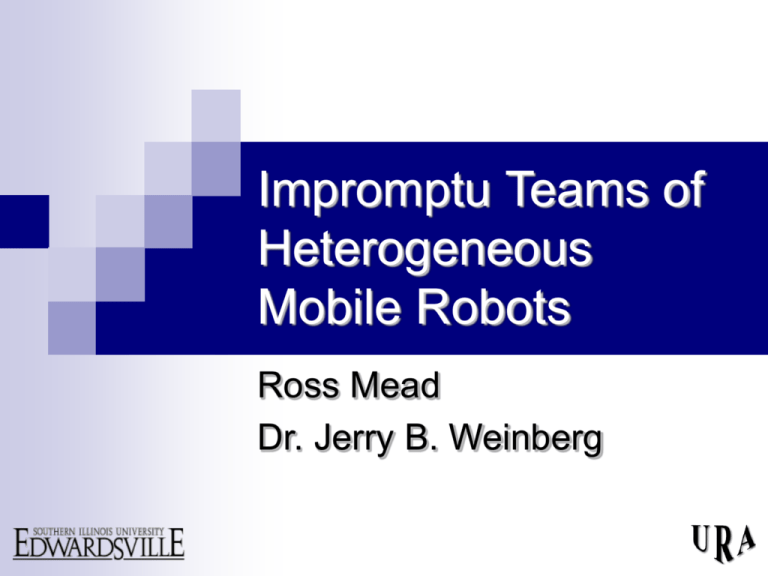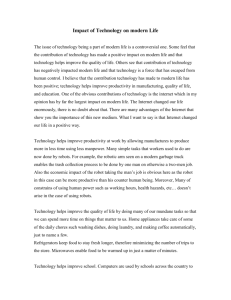Impromptu teams
advertisement

Impromptu Teams of Heterogeneous Mobile Robots Ross Mead Dr. Jerry B. Weinberg Introduction Following the World Trade Center attacks, teams of mobile robots were called to Ground Zero to aid in finding victims. This marks the first time in history that robots were used in a real search and rescue environment. Introduction The small size of these machines granted them the ability to investigate places where workers could not go. Rescuers were able to perceive and communicate with victims… using visual and audio sensors Introduction Participating teams came from different organizations across the country… had not previously met Robots were heterogeneous varied in shape, size, and functionality Introduction Based on their abilities, robot teams were assigned particular objectives… Hazardous materials Medical Logistics Planning Search-and-rescue Introduction Despite this delegation, did not demonstrate teamwork. The overall goal was the same… The robots were only aware of their own assigned tasks. Missions were carried out individually, and were limited solely to the abilities of that robot… A failure of a single unit would greatly hinder the completion of the overall search and rescue operation. Introduction How can these robots, which have never interacted, collaborate to accomplish a joint objective? How can abilities, internal knowledge, perceptual experiences, and tasks be uniformly represented and understood by all members of an impromptu robot team? composed of independent agents each unknown to the others Once this information is obtained, how can robots reorganize and delegate individual and joint objectives, based on individual abilities and limitations? Background A homogeneous team of robots has been used in a search and rescue environment. Tejada et al. (2003) Impromptu teams have been applied to the RoboCup robotic soccer league. Bowling et al. (2005) Background A theoretical foundation for teamwork among mobile robots has been provided. Cohen et al. (1991) A multi-layered approach to heterogeneous teams has been discussed and implemented. Balch et al. (2002) Background symbol grounding problem in artificial intelligence (AI), the representation of internal knowledge and how it is meaningfully interpreted as concepts in the physical world Three levels of knowledge representation: – physically similar to what it represents indexical – links between icons symbolic – provides a relationship between icons, indices, and other symbols iconic Goals/Objectives If heterogeneous robots are to organize and work together as an impromptu team, a language must be developed that allows them to share knowledge in a meaningful way. For consistent interpretation of communicated knowledge within a team, symbols representing the knowledge must be grounded in concepts... refer to categories of entities in an environment Goals/Objectives Symbolic communication protocol based upon the Semantic Web… extension of World Wide Web gives information well-defined meaning relates to the corresponding entity in the real world Goals/Objectives Goals/Objectives Information is presented in a structured form… similar to a descriptive sentence <subject> <predicate> <object> By enforcing this strict syntax, robot attributes can be broken down and related to the traits of others. This structure can easily be interpreted by both computers and people… simple to edit, search, and communicate Goals/Objectives Based on the characteristics of XML… language used to program the Semantic Web XML is able to encode metadata… information about the information XML is extensible. Goals/Objectives XML is designed so that new tags can be defined that describe new concepts and categories of information… can be shared with others searching for information The communication protocol would be layered beneath a robot’s own independent program… provide meaning to symbols relating to itself and other robots in its immediate area. Goals/Objectives A task management system is needed to complete individual and joint goals. The team must consider the individual abilities, limitations, costs, and rewards of each robot to delegate tasks and coordinate activities appropriately… must be tolerant of communication failure and dysfunctional teammates Procedures The robot coordination system will initially be implemented and tested in simulation in PyRo. programming environment for different types of robots specifics of actuators and sensors are abstracted program can be shared across different platforms ultimate tool for heterogeneous robot code portability Procedures This project will be developed within the framework of the Department of Computer Science (CS) Senior Assignment. The target task will be the American Association for Artificial Intelligence (AAAI) Robot Scavenger Hunt Challenge. Procedures A robotic system to search the Engineering Building for a list of objects will be developed… working with senior CS students Code must be portable and list of objectives must be easy to modify working with three ActivMedia robots Elmer, Taz, Marvin Procedures Working alongside the scavenger hunt project, I will be developing the robot coordination system. The scavenger hunt is, in many ways, analogous to urban search and rescue… a successful implementation of the system will show proof-of-concept of impromptu teams in a search and rescue environment References S. Westphal (2001). “Robots join search and rescue teams”, New Scientist (Online) 19 September 2001. 09 March 2006. http://www.newscientist.com/article.ns?id=dn1321 P. Cohen & H. Levesque (1991) “Teamwork,” Nous 25:11—24 R. Murphy (2004) “Human-Robot Interaction in Rescue Robotics,” IEEE Systems, Man and Cybernetics Part C: Applications and Reviews, special issue on Human-Robot Interaction, Vol. 34, No. 2, May 2004. T. Balch & L. Parker (2002) Robot Teams: From Diversity to Polymorphism, A K Peters, Ltd., Natick, Massachusetts. M. Bowling & P. McCracken (2005) “Coordination and Adaptation in Impromptu Teams,” In the Proceedings of AAAI-05. Harnad, S. (2003) The Symbol Grounding Problem, Encyclopedia of Cognitive Science, Nature Publishing Group/Macmillan. S. Tejada, A. Cristina, P. Goodwyne, E. Normand, R. O’Hara, & S. Tarapore (2003) “Virtual Synergy: A Human-Robot Interface for Urban Search and Rescue”. In the Proceedings of the AAAI 2003 Robot Competition, Acapulco, Mexico. R. Daviddson (1993) “A Framework for Organization and Representation of Concept Knowledge in Autonomous Agents,” In Scandinavian Conference of Artificial Intelligence—93, IOS Press. Semantic Web. Ed. Eric Miller, et al. 8 March 2006. W3C. 11 March 2006. http://www.w3.org/2001/sw/ Questions?



